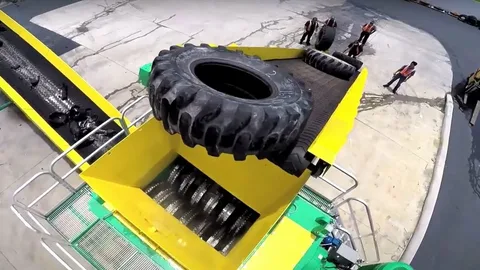Tire Shredder Market: Driving the Circular Rubber Economy

Introduction
The Tire Shredder Market is expanding as governments, recycling firms, and industries increasingly focus on sustainable waste management and circular economy practices. Tire shredders are machines designed to cut, grind, and shred used or scrap tires into smaller pieces, rubber mulch, crumb rubber, or tire-derived fuel (TDF). With over one billion tires reaching end-of-life every year globally, efficient disposal and recycling have become essential to reduce landfill waste, prevent environmental hazards, and recover valuable raw materials. Shredded tire rubber is now widely used in road construction, rubberized asphalt, playground surfaces, molded rubber products, sports fields, civil engineering, and energy recovery applications. As environmental regulations strengthen, and tire recycling becomes economically attractive, demand for advanced, energy-efficient, and high-capacity tire shredders is rising across developed and emerging markets.
Market Drivers
Increasing environmental awareness and government mandates for tire recycling are primary growth drivers. Landfilling and burning of scrap tires are being restricted due to pollution, fire risks, and soil contamination. Industries and municipalities are adopting tire shredders to comply with recycling regulations and promote sustainable waste handling. Growing demand for recycled rubber products—such as crumb rubber for athletic surfaces, construction materials, rubber mats, and molded goods—supports tire shredding operations. Tire-derived fuel (TDF) is gaining traction as a cost-efficient alternative for cement kilns, pulp & paper mills, and power plants due to its high calorific value. Rising investments in recycling plants and circular economy initiatives further accelerate equipment demand. Automotive production growth and increasing tire replacement rates also generate a steady supply of end-of-life tires for processing.
Market Challenges
High equipment and installation costs pose a challenge, especially for small recyclers. Tire shredders require robust construction, high torque, and durable blades to handle reinforced rubber and steel, increasing capital expenditure. Operational challenges include blade wear, maintenance frequency, and downtime due to heavy-duty processing. In many regions, the tire recycling ecosystem remains fragmented, with inadequate collection and segregation infrastructure. Processing end-of-life tires into high-value products requires advanced shredding, granulation, and separation systems, raising costs. Volatile pricing of recycled rubber products and competition from low-cost virgin rubber alternatives can affect profitability. Additionally, lack of awareness and weak enforcement of recycling regulations in some countries slow adoption.
Market Opportunities
Technological advancements create promising opportunities for the tire shredder market. Development of energy-efficient shredders with automated control systems, IoT-enabled monitoring, and predictive maintenance can improve performance and reduce downtime. Mobile and modular shredding units offer flexibility for on-site tire processing, supporting remote regions and smaller recycling operations. Integration of magnetic separators and granulators to produce high-purity steel and fine crumb rubber increases revenue streams. Growing use of recycled rubber in building infrastructure, athletic tracks, artificial turf infill, and eco-construction materials expands market potential. Circular economy initiatives and green building programs can boost demand for premium recycled rubber products. Emerging markets in Asia, Africa, and Latin America present untapped opportunities as governments invest in waste management reforms and recycling plants.
Regional Insights
North America leads the market due to stringent tire disposal regulations, strong recycling infrastructure, and high adoption of TDF in industrial applications. The U.S. has well-established scrap tire collection systems and large recycling plants. Europe follows closely, supported by strict EU environmental policies, circular economy directives, and widespread use of crumb rubber in construction and sports infrastructure. Germany, the UK, France, and Italy are major markets. Asia-Pacific is the fastest-growing region, driven by increasing automotive tire consumption, waste management reforms, and expanding recycling capacity in China, India, Japan, and Southeast Asia. Middle East & Africa and Latin America are emerging markets with growing focus on sustainable waste management and investments in new recycling facilities and equipment.
Future Outlook
The Tire Shredder Market will evolve with automation, circular economy initiatives, and high-value recycling applications. Advanced shredders integrated with AI-based monitoring, automatic jam control, and optimized cutting systems will enhance throughput and reduce operating costs. Adoption of end-to-end tire recycling lines—from shredding to granulating to devulcanization—will increase the value of recycled rubber, making tire recycling more profitable. Government incentives and public-private partnerships will accelerate plant installations and innovation. Sustainable product development, such as rubber-modified asphalt for roads, will drive long-term demand for shredded rubber. Over the next decade, the market will shift toward smart, energy-efficient, and environmentally compliant shredding systems supporting a global circular rubber economy.
Conclusion
The Tire Shredder Market is gaining momentum as industries embrace sustainable waste management and recycling practices. While high equipment costs, fragmented infrastructure, and market awareness gaps pose challenges, technological advancements, regulatory support, and growing applications of recycled rubber are driving adoption. With increasing environmental urgency and circular economy initiatives, tire shredders are becoming essential for converting end-of-life tires into valuable materials and energy products. Manufacturers offering durable, automated, and cost-efficient shredding solutions will play a key role in accelerating global tire recycling and reducing environmental impact.


